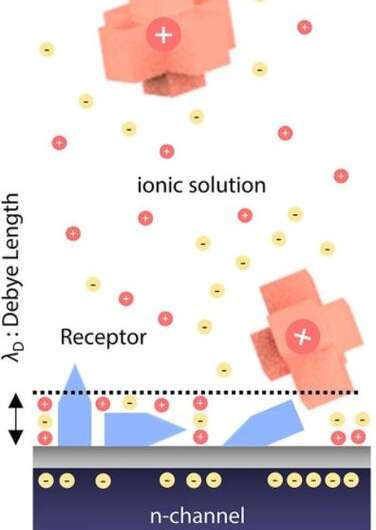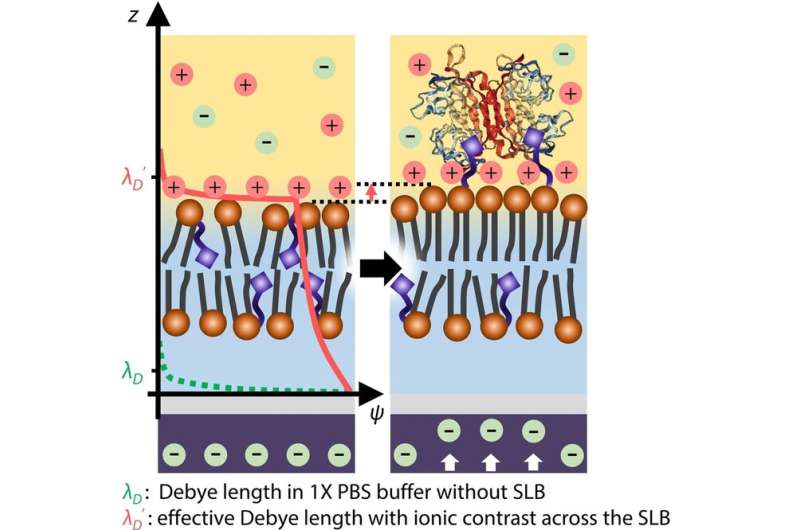Development of 'cellular membrane-FET (lipid-FET)' for sensitivity of biosensor

A Korean research team successfully developed a proprietary biosensor technology with significantly enhanced molecular sensitivity using the artificial lipid membrane that mimics cellular membrane. The research team led by Dr. Yong-Sang Ryu from the Brain Science Institute and Dr. Chul Ki Kim from the Sensor System Research Center, in collaboration with the research team led by Professor Dong June Ahn from the Department of Chemical and Biological Engineering at Korea University, developed a technology to enhance the molecular detectability over the potentiometric field-effect transistor (FET) surface via ion-impermeation across the lipid membrane.
It has been somewhat challenging to commercialize the FET-based molecular detection technology, a sensor technology using electric signals, despite its benefits in the detection of various molecules such as viruses, proteins, and DNA. This is mainly due to the ultra-thin detection ranges for molecular detection under high concentration of ions or electric charge of the analyte solution.
For instance, in one drop of blood, the effective range from which molecules can be detected over the potentiometric sensor probe is approximately 1 nm, which is thinner than the molecule to be detected and analyzed; therefore, it is difficult to detect the electric signal, even if the molecule comes in contact with the sensing probe. To overcome this hurdle, researchers have tried strategies including diluting the analyte solution up to 100,000-fold to enhance molecular detection; however, these strategies have not been successful.
Therefore, the research team proposed the use of the model membrane to overcome this obstacle. The cellular membrane of humans not only controls the ion concentration of the internal and external environment, but also prevents a high concentration of ions from entering the cell. The team thus focused on this specific characteristic of the cellular membrane-mimicking system. After repeated tests for applying the cellular membrane to the surface of the FET-based molecular detection chip, it was confirmed that molecule detection is available without additional pretreatment, even in a high-concentration ionic solution.

With this new technology, known as "membrane coated-FET (lipid-FET)," molecules suspended in highly ionic concentrated solution at the level of human blood can be detected with higher sensitivity compared to that of the existing sensor, and dilution of the solution up to 100,000-fold is not required. This was confirmed to be the highest performance among all FET reported so far globally. Research team expects that this technology can be used to diagnose various diseases related matters such as dementia-associated proteins, but it is also a platform technology with extensive applicability as biosensors in diverse fields including medicine, healthcare, and the environment for detecting viral infections and microplastics.
Dr. Yong-Sang Ryu from KIST described the research achievement as "molecule detection via lipid-FET with ionic contrast across the membrane can be instantly applied to all the existing potentiometric sensor platforms that use an electric field to detect molecules."
Dr. Chul Ki Kim from KIST said, "Studies for applying the technology to various research fields such as diseases known to be caused by mutated proteins attached to cellular membranes like Alzheimer's disease, Parkinson's' disease, and diabetes, and technology to rapidly and precisely detect an extremely small number of infectious viruses such as COVID-19 and influenza are being conducted in parallel."
The research outcome has been published in the recent issue of Nature Communications.
More information: Donggeun Lee et al, Ionic contrast across a lipid membrane for Debye length extension: towards an ultimate bioelectronic transducer, Nature Communications (2021). DOI: 10.1038/s41467-021-24122-8
Journal information: Nature Communications
Provided by National Research Council of Science & Technology




















